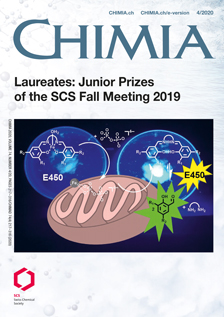Voltammetric Tracing of Al(III) Using Supramolecular Metal-Polyphenolic Nanofilms Obtained via Electrochemically Assisted Self-Assembly
DOI:
https://doi.org/10.2533/chimia.2020.289PMID:
32331549Keywords:
Aluminum sensing, Electrochemical cross-linking, Nanoparticles, Supramolecular filmAbstract
Supramolecular metal-polyphenolic thin sensor films represent a unique class of composite materials. Their properties and sensitivity can be easily modified via controlled self-assembly of their molecular components. Among the different assembly methods, electrochemically triggered processes are extremely powerful because they allow spatial confinement of the film buildup via an electrical stimuli-controlled process. In this article, an approach to employ the electrochemically assisted self-assembly of a multicomponent supramolecular film based on a naturally occurring polyphenol, tannic acid (TA), is featured. Here, the capacity of polyphenolic compounds to form complexes with metal ions, as well as to act both as reducing agents and stabilizers in colloidal synthesis of metal nanoparticles (NPs) is utilized. The electrochemically triggered self-assembly can be coupled with the ion – printing method, in which the targeted metal ion, in this case Al(III), is incorporated into the film during the synthesis and chemically removed afterwards. This procedure results in a template-like structure of the film with openings ready to bind the same metal ion from the probed solution, thus significantly improving the selectivity of the sensor formed and enhancing its applicability for sensing of toxic metal ions in complex aqueous solutions, such as physiological fluids.Downloads
Published
2020-04-29
Issue
Section
Scientific Articles
License
Copyright (c) 2020 A. Krywko-Cendrowska

This work is licensed under a Creative Commons Attribution-NonCommercial 4.0 International License.
How to Cite
[1]
A. Krywko-Cendrowska, Chimia 2020, 74, 289, DOI: 10.2533/chimia.2020.289.







